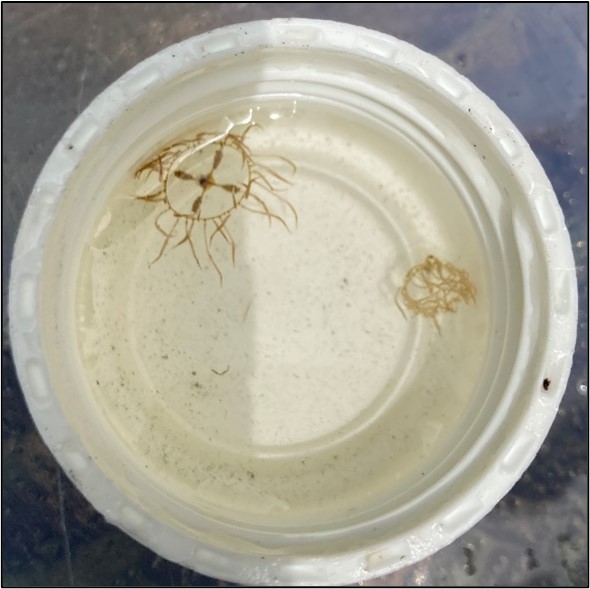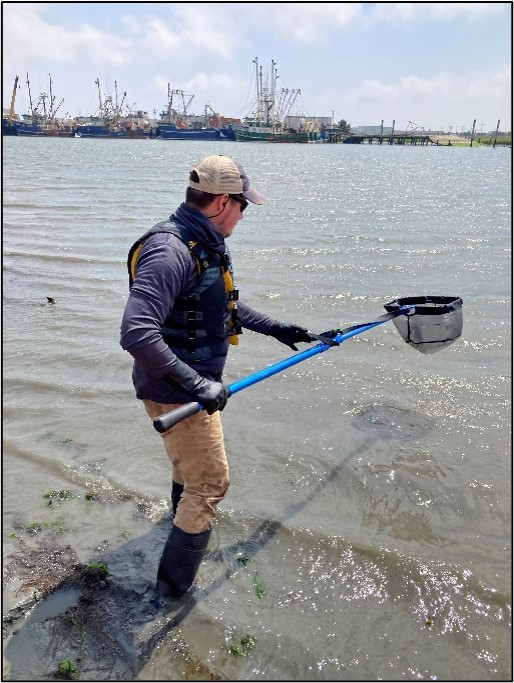(23/P038) TRENTON –The New Jersey Department of Environmental Protection reminds the public to be aware of clinging jellyfish, a small jellyfish capable of inflicting an extremely painful sting that is found in some bay and estuarine waters of New Jersey. The DEP continues to monitor populations, recently integrating a new testing technique that improves early detection capabilities through environmental DNA, or eDNA, markers in the water column.
 “Fortunately, populations of clinging jellyfish and their distribution have been largely stable since the species was first confirmed in New Jersey in 2016,” said Commissioner of Environmental Protection Shawn M. LaTourette. “However, clinging jellyfish pack such a potentially powerful sting that it is important for the public to be vigilant and take precautions when recreating in coastal bays and rivers where they are found.”
“Fortunately, populations of clinging jellyfish and their distribution have been largely stable since the species was first confirmed in New Jersey in 2016,” said Commissioner of Environmental Protection Shawn M. LaTourette. “However, clinging jellyfish pack such a potentially powerful sting that it is important for the public to be vigilant and take precautions when recreating in coastal bays and rivers where they are found.”
It is highly unlikely for clinging jellyfish to be found in ocean waters or beaches in New Jersey. Rather, the species prefers shallow, slow-moving estuarine waters, where they attach themselves to algae or marine vegetation such as eel grass.
To minimize chances of an encounter, the DEP urges the public to:
- Avoid wading into areas where the species has been observed; clinging jellyfish attach themselves to algae and submerged aquatic vegetation such as seagrass.
- Reduce the risk of being stung by wearing waders and long-sleeved clothing in these waters.
Reactions to stings can vary from person to person. Those who are stung by a clinging jellyfish will experience an initial burning sensation.
If stung by a clinging jellyfish:
- Rinse the area with saltwater and remove any remaining tentacle materials using gloves, a plastic card or a thick towel.
- If symptoms persist or pain increases instead of subsiding, seek prompt medical attention.
Clinging jellyfish range from the size of a dime to a quarter. Adults are marked by a distinctive reddish-orange to yellowish cross within their translucent bodies.
 “Monitoring of invasive species is critical for science and management, especially when they potentially pose a threat to human health,” said Dr. Paul Bologna, a Montclair State University marine biologist who closely tracks the species in partnership with the DEP. “Clinging jellyfish are small, but they can produce severe pain in people who are stung in the shallow bays of New Jersey and New England. Since we can’t be everywhere, the public is often our best source of information. Many eyes on the water help us confirm new areas where they are located to better inform the public and keep everyone safe.”
“Monitoring of invasive species is critical for science and management, especially when they potentially pose a threat to human health,” said Dr. Paul Bologna, a Montclair State University marine biologist who closely tracks the species in partnership with the DEP. “Clinging jellyfish are small, but they can produce severe pain in people who are stung in the shallow bays of New Jersey and New England. Since we can’t be everywhere, the public is often our best source of information. Many eyes on the water help us confirm new areas where they are located to better inform the public and keep everyone safe.”
A recent study commissioned by the DEP in collaboration with Rutgers University’s Department of Ecology, Evolution, and Natural Resources aims to make it easier to detect the location and monitor the number of various species of cnidarians – a group of animals equipped with stinging cells that includes clinging jellyfish and other types of jellyfish – by testing water samples for their eDNA, which are identifiers found within the water column.
“Environmental DNA allows us to detect invasive species at much lower numbers than our usual sampling methods, so we can more quickly address the issues faced by all who make use of New Jersey's coastal waters,” said Anthony Vastano, a Laboratory Researcher in the Rutgers eDNA Lab. “It's an amazing technology that, beyond detecting invasive species, has the potential to quickly characterize the entire cnidarian community by simply collecting a bottle of water, filtering it down, and analyzing the sample back at the lab. We can already do this for fish, and so adding cnidarians to our species portfolio can give us a clearer picture of how the aquatic community is responding to our changing environment.”
Cnidarians are a critical part of coastal ecosystems, serving as key predators within the marine food web. However, warming water temperatures associated with climate change, as well as other environmental factors, are allowing some species to increase in numbers and move into new ecosystems as invasive species, increasing risk and importance of early detection.
Clinging jellyfish are a non-native species that was first confirmed in New Jersey in 2016. The species, native to the Pacific Ocean, likely was transported to the East Coast in ballast water from ships or being attached to ships’ hulls, perhaps as early as the late 1800s in New England. They can be found from Maine to New Jersey.
In New Jersey, clinging jellyfish populations are established in several locations including the Metedeconk River, the bayside of Island Beach State Park, the Shrewsbury River, a salt pond in North Wildwood located adjacent to Hereford Inlet Lighthouse, Lower Township Thorofare (a type of coastal waterway) and the Cape May National Wildlife Refuge. The jellyfish are found from mid-May to late July, or until bay water temperatures reach or exceed 82 degrees Fahrenheit.
Adult clinging jellyfish prefer to be attached to eelgrass and seaweed during the day but become active in the water column if disturbed and after sunset. If disturbed, they will attempt to reattach to the substrate, which provides shelter and protection. For more information, see DEP’s Clinging Jellyfish Fact Sheet.
The public can find confirmed clinging jellyfish locations on the NJ Clinging Jellyfish Interactive Map. The map is updated weekly as research scientists from the DEP and Montclair State University continually monitor areas where the species are established and investigate reported sightings and places with suitable habitat.
In addition to seasonal monitoring and tracking the species’ presence, researchers study their feeding and reproductive behaviors and water chemistry conditions, as well as conduct habitat surveys and source tracking projects.
The DEP also relies on reports from the public to help track clinging jellyfish populations. Anyone who encounters clinging jellyfish should not touch them and immediately leave the area and, if possible, take a photo and send GPS coordinates to the DEP at joseph.bilinski@dep.nj.gov.
More information on clinging jellyfish and other jellyfish species can be found at New Jersey Jellyfish Information.
###
 Official Site of The State of New Jersey
Official Site of The State of New Jersey
 “Fortunately, populations of clinging jellyfish and their distribution have been largely stable since the species was first confirmed in New Jersey in 2016,” said Commissioner of Environmental Protection Shawn M. LaTourette. “However, clinging jellyfish pack such a potentially powerful sting that it is important for the public to be vigilant and take precautions when recreating in coastal bays and rivers where they are found.”
“Fortunately, populations of clinging jellyfish and their distribution have been largely stable since the species was first confirmed in New Jersey in 2016,” said Commissioner of Environmental Protection Shawn M. LaTourette. “However, clinging jellyfish pack such a potentially powerful sting that it is important for the public to be vigilant and take precautions when recreating in coastal bays and rivers where they are found.” “Monitoring of invasive species is critical for science and management, especially when they potentially pose a threat to human health,” said Dr. Paul Bologna, a Montclair State University marine biologist who closely tracks the species in partnership with the DEP. “Clinging jellyfish are small, but they can produce severe pain in people who are stung in the shallow bays of New Jersey and New England. Since we can’t be everywhere, the public is often our best source of information. Many eyes on the water help us confirm new areas where they are located to better inform the public and keep everyone safe.”
“Monitoring of invasive species is critical for science and management, especially when they potentially pose a threat to human health,” said Dr. Paul Bologna, a Montclair State University marine biologist who closely tracks the species in partnership with the DEP. “Clinging jellyfish are small, but they can produce severe pain in people who are stung in the shallow bays of New Jersey and New England. Since we can’t be everywhere, the public is often our best source of information. Many eyes on the water help us confirm new areas where they are located to better inform the public and keep everyone safe.”